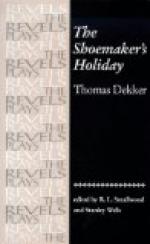|
This section contains 5,007 words (approx. 17 pages at 300 words per page) |

|
SOURCE: “Workshop and/as Playhouse: Comedy and Commerce in The Shoemaker's Holiday,” in Studies in Philology, Vol. LXXXIV, No. 3, Summer 1987, pp. 324-37.
In the essay below, Kastan maintains that The Shoemaker's Holiday is “a realistic portrait only of Elizabethan middle-class dreams—a fantasy of class fulfillment that would erase the tensions and contradictions created by the nascent capitalism of the late sixteenth-century.”
Nothing is proposed but mirth,” Thomas Dekker assures his readers in the dedicatory epistle to The Shoemaker's Holiday. “I present you here with a merry conceited comedy,” he says, a play that had recently been acted before the Queen, that ever enthusiastic though hyper-sensitive theatre-goer, whose pleasure Dekker presents as evidence of the innocence of his offering: “the mirth and pleasant matter by her Highness graciously accepted, being indeed no way offensive.”
Certainly critics have generally taken Dekker at his word. We are told again and...
|
This section contains 5,007 words (approx. 17 pages at 300 words per page) |

|


